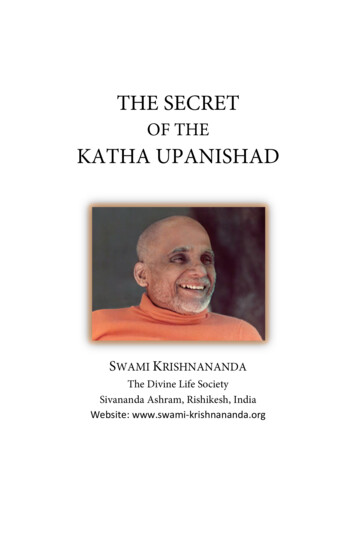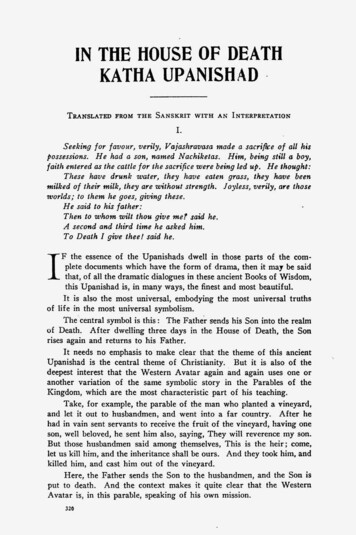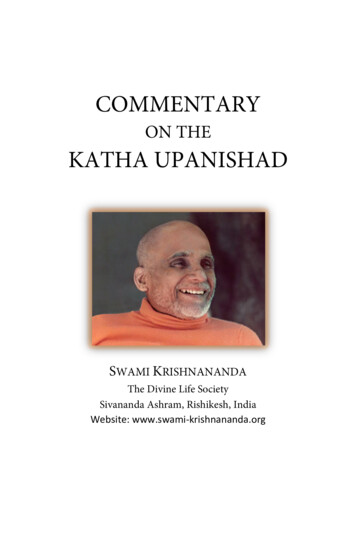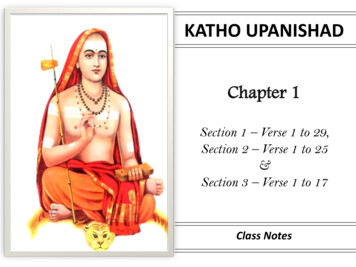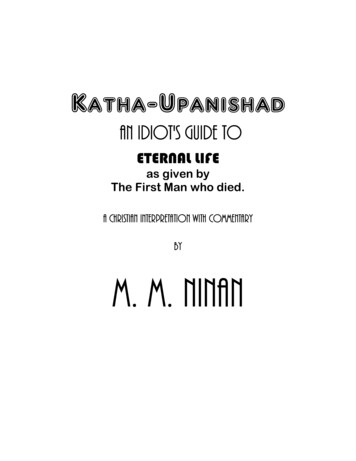
Transcription
Katha-UpanishadAN IDIOT'S GUIDE TOETERNAL LIFEas given byThe First Man who died.A CHRISTIAN INTERPRETATION WITH COMMENTARYBYM. M. NINAN
KATHA-UPANISHADAN IDIOT'S GUIDE TO ETERNAL LIFEas given by The First Man who died.A CHRISTIAN INTERPRETATION WITH COMMENTARYBY M. M. NINANSan Jose, CA 951232014
KATHA-UPANISHADAN IDIOT'S GUIDE TO ETERNAL LIFEas given by The First Man who died.A CHRISTIAN INTERPRETATION WITH COMMENTARYBYM. M. NINANINTRODUCTIONPART IVALLI 1VALLI IIVALLI IIITWO ROADSTWO HOUSEHOLDERS IN THE CAVE14676PART IIGARLAND OF GEMSVALLI IVVALLI VVALLI VI115132145
of
auṁ sa ha nāv avatu,OM! May He protect us both.saha nau bhunaktu,May He cause us both to enjoy the bliss of Mukti.saha vīryam karavāvahai,May we both exert to find out the true meaning of the scriptures.tejasvi nav adhītam astu:May our studies be fruitful.mā vidviṣāvahai; auṁ śāntih, śāntih, śāntih.May we never quarrel with each other.
IntroductionThe Upanishads are a collection of teachings passed down from teacher to the studentin a series. They are all written in Classical Sanskrit and hence were written down onlyafter the development of Classical Sanskrit, which is, dated as the second half of theChristian era. These are definitely post Vedic, post Buddhist and post Jainism and arecalled Vedanta or the end of the Vedas. They form the core of Vedanta and Samkhyaphilosophies. Since they are carried from teacher to Student they are considered asrevealed truths (Sruti heard truths) concerning the nature of ultimate reality (Brahman)and describing the character and form of human salvation (moksha). The Upanishadsare later than the Brahmanas and Aranyakas. The Brahmanas are glosses on themythology, philosophy and rituals of the Vedas. "Aranyaka" (āraṇyaka) ("belonging tothe wilderness" (araṇya)) contain Brahmanic style discussion of priestly ritualsassociated with the Vedic rituals. Though it is claimed that Upanishads have beenorally transmitted from generations to generations even before the Christian Era there isno way we can ascertain their origin. It is certain that they were written down as wehave to day only after the second century AD. Earliest documented Sanskrit occursonly by 150 AD. The classical period of Sanskrit literature dates to the Gupta period andthe successive pre-Islamic Middle kingdoms of India, spanning roughly the 3rd to 8thcenturies CE."The oldest of these, the Brihadaranyaka and Chandogya Upanishads, were assignedthe period during the pre-Buddhist era of India, while the Taittiriya, Aitareya andKausitaki, which show Buddhist influence, must have been composed after thedevelopment of Buddhism The remainder of the mukhya Upanishads are by commonconsensus dated to the first two centuries of the Common Era. The new Upanishadswere composed in the medieval and early modern period: discoveries of newerUpanishads were being reported as late as 1926. One, the Muktikā Upanishad,predates 1656 and contains a list of 108 canonical Upanishads, including itself as thelast. However, several texts under the title of "Upanishads" originated right up to the first
half of the 20th century, some of which did not deal with subjects of Vedic philosophy.The newer Upanishads are known to be imitations of the mukhya Upanishads.The Upanishads have been attributed to several authors: Yajnavalkya and UddalakaAruni feature prominently in the early Upanishads.Other important writers includeShwetaketu, Shandilya, Aitreya, Pippalada and Sanat Kumara. Important womenauthors include Yajnavalkya's wife Maitreyi, and Gargi. Dara Shikoh, son of the Mughalemperor Shah Jahan, translated 50 Upanishads into Persian in 1657. The first writtenEnglish translation came in 1804 from Max Müller, who was aware of 170 Upanishads.Sadhale's catalog from 1985, the Upaniṣad-vākya-mahā-kośa, lists 223 Upanishads.The Upanishads are mostly the concluding part of the Brahmanas, and the transitionfrom the latter to the former is identified as the Aranyakas."(as quoted from https://www.princeton.edu/ achaney/tmve/wiki100k/docs/Upanishad.html)More than 200 Upanishads are known, of which the first dozen or so are the oldest andmost important and are referred to as the principal or main (mukhya) Upanishads. NewUpanishads continues to be written at least to the 20th century. Like Brahmanas, andAranyakas, the Upanishads, Puranas and Sutras were associated with some Vedaarbitrarily for claiming authority.The Katha Upanishad (Kaṭhopaniṣad, also Kāṭhaka), also titled "Death as Teacher", isone of the mukhya("primary") Upanishads commented upon by Shankara andMadhva."The Upanishads were translated from Sanskrit into Persian by, or, it may be, for DârâShukoh,(1615-1659 AD) the eldest son of Shâh Jehân."
"The Upanishads were translated from Sanskrit into Persian by, or, it may be, for DârâShukoh,(1615-1659 AD) the eldest son of Shâh Jehân, an enlightened prince, whoopenly professed the liberal religious tenets of the great Emperor Akbar, and even wrotea book intended to reconcile the religious doctrines of Hindus and Mohammedans. Heseems first to have heard of the Upanishads during his stay in Kashmir in 1640. Heafterwards invited several Pandits from Benares to Delhi, who were to assist him in thework of translation. The translation was finished in 1657. Three years after theaccomplishment of this work, in 1659, the prince was put to death by his brotherAurangzib , in reality, no doubt, because he was the eldest son and legitimatesuccessor of Shâh Jehân, but under the pretext that he was an infidel, and dangerousto the established religion of the empire." (Max Muller)A page from Majma-ul-Bahrain (a book on comparative religion by Muhammad DaraSikoh ("The Confluence of the Two Seas")) in the manuscripts collection at the PortraitGallery of Victoria memorial, Calcutta.
Dara Shukoh, the eldest son of Emperor Shahejahan, was born of his beloved queenMumtaz Mahal, of the Taj Mahal fame. He was born in Ajmer and it is said that he wasborn with the blessings of Khwaja Muinuddin Hassan Chishti Ajmeri, on 19 Safar 1024A.H. - 20th day of March, 1615 A.D. His grandfather Emperor Jehangir named him DaraShukoh - King of Glory.When Shahjahan fell seriously ill in 1675 A.D. he passed orders that Dara Shukohsucceeded him as Emperor of Delhi and desired that all officials of the State obeyedhim. Dara Shukoh was Tassawwuf (which means the path of the Sufis - the woollenclothed ones; the mystic Gnostic group of Islam), and maintained association withHindu yogis and sanyasis. On this pretext Aurangzeb accused him as a heretic andunsuitable for the Islamic Throne. in a fierce battle at Samugarh, at a distance of eightmiles from Delhi, on the 29th day of May, 1658 A.D. Dara Shukoh was defeated in theensuing was of Samugarth eight miles away from Delhi and Aurangzeb, his youngerbrother was declared the Emperor of Mughal empire of India.Dara Shukoh fled to the Punjab, on way to Iran, to seek succor from Shah Abbas II butwas betrayed by Afghan Bulooch Sardar Malik Jiwan, whose life Dara had saved onceat Bolan Pass. Dara Shukoh, along with his son Sipar Shukoh and two daughters, washanded over to commander Bahadur Khan who conveyed them to Delhi on the 23rd dayof August, 1659 A.D.At Delhi he was presented before the Sharia Court and was executed for apostasy onthe 30th day of August, 1659 A.D. He was buried in the compound of Humayun'smaqbara - in an unknown tomb.Dara Shikoh is widely renowned as an enlightened paragon of the harmoniouscoexistence of heterodox traditions on the Indian subcontinent. He was an eruditechampion of mystical religious speculation and a poetic diviner of syncretic culturalinteraction among people of all faiths. This made him a heretic in the eyes of hisorthodox brother and a suspect eccentric in the view of many of the worldly powerbrokers swarming around the Mughal throne. Dara was a follower of the Persian"perennialist" mystic Sarmad Kashani, as well as Lahore's famous Qadiri Sufi saint
Hazrat Mian Mir, whom he was introduced to by Mullah Shah Badakhshi (Mian Mir'sspiritual disciple and successor) and who was so widely respected among allcommunities that he was invited to lay the foundation stone of the Golden Temple inAmritsar by the Sikhs.Dara subsequently developed a friendship with the seventh Sikh Guru, Guru Har Rai.Dara devoted much effort towards finding a common mystical language between Islamand Hinduism. Towards this goal he completed the translation of 50 Upanishads from itsoriginal Sanskrit into Persian in 1657 so Muslim scholars could read it. His translation isoften called Sirr-e-Akbar (The Greatest Mystery), where he states boldly, in theIntroduction, his speculative hypothesis that the work referred to in the Qur'an as the"Kitab al-maknun" or the hidden book, is none other than the Upanishads. His mostfamous work, Majma-ul-Bahrain ("The Confluence of the Two Seas"), was also devotedto a revelation of the mystical and pluralistic affinities between Sufic and Vedanticspeculation.The library established by Dara Shikoh still exists on the grounds of Guru Gobind SinghIndraprastha University, Kashmiri Gate, Delhi, and is now run as a museum byArcheological Survey of India after being renovated. Under Akbar's reign (1556-1586)similar translations had been prepared "Dara Shukoh wrote many books, most of these are in Persian:In 'Majmaa-ul-Bahreen', ' (Mingling of Two Oceans) Dara compares the teachings of theUpanishads in the context of Sufic understanding of God. In Sirr-e-Akbar - The secretof secrets - Dara speaks of the depth of understanding of the Upanishads. In itsforeword Dara Shikoh writes that, "I had collected a large number of Hindu pundits andsanyasis from Benaras, the center of the Hindu lore and wisdom, with whose help Icompleted this work within six months in Delhi", i.e. by the 28th of June, 1675 A.D. Hewas 42 years of age then.Anquietil Duperron, a French scholar translated the Persian texts into French, and laterinto Latin, in 1801-1802 A.D.Guru Gobind Singh (1666-1708 A.D.), Tenth Guru of the Sikh faith, builder of the KhalsaSinghs (1699 A.D.) is believed to have ordered the translation of the Persian book Sirre-Akhar into Punjabi (Gurmukhi).
Later Raja Ram Mohun Roytranslated the Upanishads into Bengali, Hindi, andEnglish. He rejected the Puranas and all its mythological stories.Raja Ram Mohan Roy (1772-1833) is known as the 'Maker of Modern India'. He was thefounder of the Brahmo Samaj, one of the first Indian socio-religious reform movements.He played a major role in abolishing the role of Sati. Raja Rammohan Roy was a greatscholar and an independent thinker. Founded Atmiya Sabha and Brahma Samaj. TheBrahmo Samaj, established in 1828, aimed to reform Hinduism by banishing the castesystem, idolatry, and other features of Indian life. The Samaj including Roy,Devendranath Tagore (1817–1905), and Keshub Chunder Sen (1838–1884) — weretheists who stressed the worship of one God, omniscient and omnipotent. All truth isfrom God, and the prophets of all religions were to be respected. It has since appearedin various languages; and English, German and French .
Max Müller (1823 -1900) translated it 1879.Prof. Muller's introduction to his translation gives much insight into the development ofthe Upanishad. Hence I am giving it here: The Katha UpanishadTranslated by F. Max MüllerTranslator's IntroductionTHE KATHA-UPANISHAD is probably more widely known than any other Upanishad. Itformed part of the Persian translation, was rendered into English by Râmmohun Roy,and has since been frequently quoted by English, French, and German writers as one ofthe most perfect specimens of the mystic philosophy and poetry of the ancient Hindus.It was in the year 1845 that I first copied at Berlin the text of this Upanishad, thecommentary of Sankara (MS. 127 Chambers1. MS. 133 is a mere copy of MS. 127.),and the gloss of Gopâlayogin (MS. 224 Chambers). Dr. Roer in the Bibliotheca Indica,with translation and notes, has since edited the text and commentary of Sankara andthe gloss of Ânandagiri. There are other translations, more or less perfect, byRâmmohun Roy, Windischmann, Poley, Weber, Muir, Regnaud, Gough, and others. Butthere still remained many difficult and obscure portions, and I hope that in some at leastof the passages where I differ from my predecessors, not excepting Sankara, I mayhave succeeded in rendering the original meaning of the author more intelligible than ithas hitherto been.The text of the Katha-upanishad is in some MSS. ascribed to the Yagur-veda. In theChambers MS. of the commentary also it is said to belong to that Veda [2 YagurvedeKathavallîbhâshyam.] and in the Muktikopanisbad it stands first among the Upanishadsof the Black Yagur-veda. According to Colebrooke (Miscellaneous Essays, 1, 96, note)it is referred to the Sâma-veda also. Generally, however, it is counted as one of theÂtharvana Upanishads.The reason why it is ascribed to the Yagur-veda, is probably because the legend ofNakiketas occurs in the Brâhmana of the Taittirîya Yagur-veda. Here we read (III, 1, 8):
Vâgasravasa, wishing for rewards, sacrificed all his wealth. He had a son, calledNakiketas. While he was still a boy, faith entered into him at the time when the cowsthat were to be given (by his father) as presents to the priests, were brought in. He said:'Father, to whom wilt thou give me?' He said so a second and third time. The fatherturned round and said to him: 'To Death, I give thee.'Then a voice said to the young Gautama, as he stood up: 'He (thy father) said, Go awayto the house of Death, I give thee to Death.' Go therefore to Death when he is not athome, and dwell in his house for three nights without eating. If he should ask thee, 'Boy,how many nights hast thou been here?' say, 'Three.' When he asks thee, 'What didstthou eat the first night?' say, 'Thy o
The Katha Upanishad (Ka ṭhopaniṣad, also Kā ṭhaka), also titled "Death as Teacher", is one of the mukhya ("primary") Upanishads commented upon by Shankara and Madhva. "The Upanishads were translated from Sanskrit into Persian by, or, it may be, for Dârâ Shukoh,(1615-1659 AD) the eldest son of Shâh Jehân." "The Upanishads were translated from Sanskrit into Persian by, or, it .
